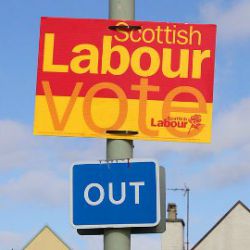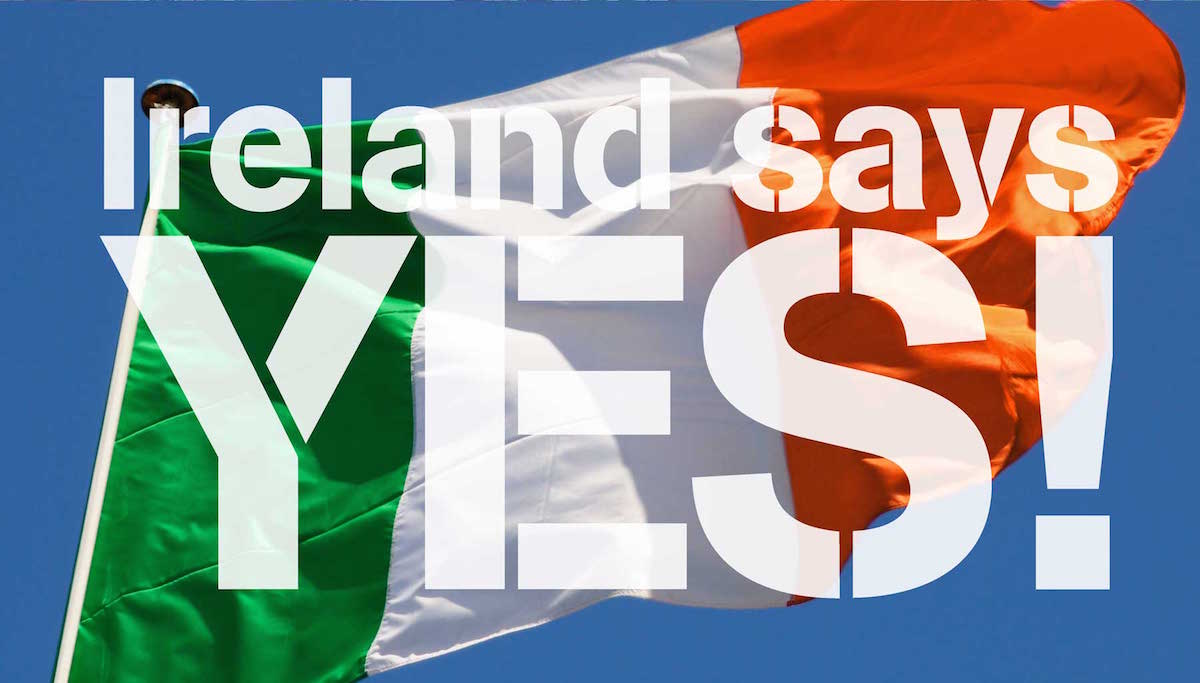
Alongside the shock of a Tory majority, the other big story of the General Election results was that of Labour’s collapse in Scotland to the SNP. With the Nationalists very nearly sweeping the board with 56 out of 59 seats, it more than negated any small increase in votes Labour got in England and Wales.
The SNP managed 50% of the popular vote, a feat last achieved famously not by Labour, but by the Scottish Conservatives (then the Unionist Party) in 1955. Scottish turnout was 71%, higher than the UK average of 66%, showing the continued effect of the politicisation that occurred off the back of the Referendum – although down on the record turnout in September of 85%. Record breaking swings saw one Labour stronghold after another fall.
A sense of history
Going into the election, an anonymous Scottish Labour MP had described the situation of the party in Scotland as being at “Defcon F**ked” – in other words, off the charts bad.

This proved to be the case. The seat of Coatbridge, Chryston and Bellshill, once a centre of coalmining, engineering and metalworking, and where Labour’s Tom Clarke had sat as MP for over three decades, fell with a swing of 36.2%. Gordon Brown’s former seat of Kirkcaldy and Cowdenbeath in the Fife coalfield went with a 34.6% swing. Glasgow North East, dominated at one time by locomotive works which produced one third of Britain’s trains, and whose skyline is marked by the famous (and soon to be former) Red Road high-rises, went with what must be a record-breaking 39.3% swing. Shadow Foreign Secretary Douglas Alexander (a former government minister) lost his seat to the SNP’s Mhairi Black, a 20-year-old politics student, in the former mill town of Paisley.
A sense of history hangs heavy in these communities, scenes of industries and daily struggles past which came to shape the development of the Scottish Labour Party and its working class vote. It was to this sense of tradition and history that the party has appealed to again and again to get out its vote. History alone is insufficient to win elections, as was proved by the election results. Labour in Scotland are ignominiously left with just one MP, Ian Murray in Edinburgh South – the same number as the Tories and Lib Dems.
History hangs heavy upon this for other reasons too. It is the first time in nearly 110 years that Glasgow has not had a single Labour MP. You would have to go back to the 1918 General Election to find a time when Labour won a smaller percentage of the Scottish vote than on Thursday, and to before 1906 to when they won fewer seats.
Labour’s programme
How did it come to this? It is true that the Lib Dem vote collapsed in Scotland, with the SNP doing their best to hoover this up. However, it is clear that the primary victim of the SNP’s success is Labour. After five years of an austerity coalition, Labour’s best effort to oust the Tories was symbolically marked by Miliband’s decision to have six key election promises carved into an 8ft tall stone tablet at the reputed cost of £30,000. The giant plinth’s resemblance to a gravestone is an irony not lost on many.
As we have said before, Labour’s manifesto was incredibly weak. There was a sprinkling of reforms such as aims to freeze energy prices, ending ‘non dom’ status for millionaires (which although unlikely to be put into practice was at least on paper quite radical sounding), and raising the minimum wage. However, what dominated the leadership’s rhetoric and the headlines was that of Tory-lite austerity and “balancing the books”, which even included a commitment to achieving a “budget surplus,” as if trying to go one better than the Tories on the cuts front was going to have wide appeal.
This highlighted the contradictory class forces at play, with the party hierarchy caught between the need to appeal to its working class vote on the one hand, and with the pressure of British capitalism in a protracted crisis (and its propagandists in the media) demanding cuts and ‘economic credibility’ on the other. It is hardly any wonder that turnout for Labour was poor. Previously we had thought that the factor of the working class turning out, holding their noses and casting a vote for Labour would be enough – just about – to get rid of the hated Tory-Lib Dem government. However, so weak was Labour’s programme that even this did not materialise to the extent needed to boot out the Tories.
This underlines how right-wing the party’s leadership have become and the resulting erosion of its links with the working class. The argument is already being made by the Labour right wing that this is because the poor are disconnected from political affairs and therefore the only ground worth fighting for is the mythical ‘middle England’ and the Tory seats in the south east – as though the working class does not exist beyond the cloth cap wearing environs of Wales and northern England.
On the contrary, the fault for five years of majority Tory government and the lack of mobilisation against it lies squarely at the door of Labour’s leaders and their pro-capitalist programme. This mirrors the degeneration and electoral decline of Labour’s sister parties in Europe – PASOK in Greece, PSOE in Spain, or the completely supine SPD in Germany. The degeneration of the reformist parties is an international process.
Scotland and the SNP
North of the border, the added factor of Labour’s shameful role in the Better Together campaign during the Independence Referendum further compounded this process. The weakness of the Tories in Scotland meant that it was Labour who were the prime defenders of Queen and Country in a hopelessly right-wing campaign. The repeated emphasis of Labour politicians then and since on “defending the Union” and “stopping the break-up of Britain” is a language completely devoid of class content and entirely one of British nationalism. This underlines their slavish maintenance of British capitalism.
In contrast with this, a pro-independence campaign based around slogans of breaking with austerity and ‘no more Tory rule’ connected with a wide layer of the working class and resulted in the SNP’s massive growth in membership after the referendum. The ensuing General Election campaign was fought on a similar basis. The prospect opened up that if the result was a minority Labour government, the SNP may end up having the decisive balance of power at Westminster.
Sturgeon’s appeal both to the Scottish electorate, and then to a wider audience via the televised leader’s debates, that the SNP would offer their hand in support to Labour so long as they broke with austerity had a large response. Of course, within the SNP manifesto were cuts and immigration controls as well, but very few people nitpick a party’s manifesto – it’s what the leaders say which counts for more.
The Daily Mail and all the rest of gutter press, as well as their echoes in the political class, were apoplectic with rage at this. Fearmongering that the SNP would be the tail wagging Labour’s dog, as well as putting forward a most virulent and nasty “Little Englander” propaganda, showed how riled up a section of the British ruling class were by Sturgeon’s performance and promise.
However, for many working class people, not just in Scotland but indeed across Britain, this appeal was immensely popular. It further bolstered the SNP support and put increasing pressure on Miliband to be open to such a deal. After the debates there was even a swathe of English voters writing to the SNP or posting opinion online along the lines of “how do I vote SNP in England?”
Miliband was swayed, however. Pressure mounted from his Scottish party’s leadership, fearing electoral oblivion, as well as from the ruling class and their mouthpiece in the Tories, to come down firmly against any sort of coalition or voting arrangement with the SNP. In the end he did, saying that the only way to get a Labour government was by voting Labour and that there would be no deals with the nationalists.
Despite the contempt the political class show for them, the electorate are not stupid. It was clear that either Miliband would have to backtrack on this pledge, or else the only options as an alternative would be: a coalition with the hated Lib Dems, who were unlikely to gain enough seats to do so; an even more unlikely Labour majority; or, monstrously, relying on Tory support for budget cuts. This tactic was disastrous. After years of austerity and a feeling of being taken for granted as simple vote fodder, working class Scots turned away from Labour en masse and voted overwhelmingly for the SNP.
“Less popular than herpes”
What of Jim Murphy and Scottish Labour? Leader Murphy lost his seat to the SNP, a massive blow to his and the party’s prestige. In spite of this, he refused to stand down, whilst Clegg, Miliband and Farage did the morning after. This led to the ridiculous spectacle of him holding out in spite of mounting opposition. Unite the Union were among the first to call on him to stand down. A senior Labour MSP, voicing their disbelief to the Sunday Herald (10/05/15), said they could not believe he was hanging in there as he was “less popular than herpes”.

With one CLP after another calling on him to go, and only narrowly winning a vote of no confidence among the Scottish party leadership, he stepped down. He will remain in the post for another month, and has been quick to snipe at those who demanded he resign, stating that “The Labour Party’s problem is not the link with trade unions…it is the destructive behaviour of one high profile trade unionist. The leader of the Scottish Labour Party doesn’t serve at the grace of Len McCluskey, and the next leader of the UK Labour Party should not be picked by Len McCluskey.” He also supported Scottish Labour moving on with reforms toward ‘one member one vote’ (OMOV) which would remove union votes as an affiliate, being based upon just party members. Whether Dugdale will carry on his work to its completion remains to be seen. Murphy and his careerist kind have infected the Labour Party, although the disappearance of the sore does not necessarily mean the disappearance of the virus itself.
How times change. Just six months ago Murphy was celebrating his leadership election victory. A massive endorsement from the party membership (some 60% voted for him) and the inability of left candidate Neil Findlay to mobilise effectively against him (there was only 10% turnout in the union vote) seemed to boldly underline the seemingly inevitable continuing triumph of the right wing in the party.
In December and January he repeatedly declared, in spite of continued evidence to the contrary from the opinion polls, that Labour would “not lose one seat to the SNP”. Under pressure from Sturgeon’s anti-austerity slogans, Murphy even went so far as to say that there would be ‘no cuts’ under a Labour government. He did this only to be taken down a peg by Labour’s Shadow Business Secretary at Westminster, Chuka Umunna, who dismissed this and sneeringly said “the leader of the Scottish Labour Party will not be in charge of the UK budget.”
The message was clear. Murphy should pipe down and let the grown ups get on with the real politics. It further underlined the perception that Scottish Labour is a second-rate branch office of the Westminster party. You would almost feel sorry for him had he not been one of the most craven opportunists in the recent history of Labour, which is saying something.
This moderate shift to the left in words showed the desperation of Scottish Labour’s leadership. Even if Murphy had genuinely turned to the left, Labour would still have been in for a pasting in Scotland, so deep is the anger and distrust of the party at this moment in time. The SNP surge affected even the left Labour candidates who had opposed Murphy’s leadership, with a 23.3% swing against Katy Clark in North Ayrshire and Arran for example. Now the Labour Party is in disarray once more, and in an even deeper crisis.
Where next?
Already the knives of the Blairites have been sharpening for a contest. According to these creatures, the Labour manifesto was “too left” . “We spoke to our core voters but not to aspirational, middle-class ones” writes Chuka Umunna in the Observer on Saturday (09/05/15). “We need a different, big-tent approach – one in which no one is too rich or poor to be part of our party.” Umunna initially put himself forward for the top job, but in spite of his withdrawal the parameters by which the contest will be fought are clear. It will be a battle for the victory of a Blair Mk.II to head the Labour Party.
The despicable sight of Mandelson and the messiah Blair himself crawling out of the woodwork is no doubt a sign of a concerted effort to further strengthen a rightward shift in the party and strangle any remaining links with the trade unions. Andy Burnham looks to be a potential front runner in the contest, with Yvette Cooper his most experienced opponent. Previously regarded as a soft-left, Burnham made his opening gambit one of hard-right Blairism, talking of ‘aspiration’, being ‘pro-business’, as well as urging Cameron to hold the EU referendum a year earlier so as to review the situation of the Mediterranean migrants.
The rest are no better. In terms of his analysis of the situation in Scotland, Umunna writes “it is true, the rise of nationalism there was a factor that has deep, cultural roots”. This shows a complete and utter misunderstanding once more of Labour’s unpopularity and the ideological bankruptcy of the Labour leadership. There is no mass tradition of nationalism in Scotland. Even the referendum vote in itself was not an endorsement of nationalism – for the vast majority who voted Yes it was for breaking with the rotten status quo.
Since then, a number who have been drawn toward the SNP may draw conclusions for a time of this being a fight between Scotland and the rest of Britain, or ‘standing up for Scotland’ as was an SNP slogan at the election. This is a nationalist position, devoid of class content. However the reason for this is not one with “deep cultural roots”, but the withering and rot of Labour’s roots in the Scottish working class. This of course is entirely down to Labour’s subservience to capitalism. A further rightward shift in Labour will only serve to strengthen this tendency.
Will there be a left challenge to Dugdale in Scotland? The left candidate at the Scottish Labour leadership election last year, Neil Findlay MSP, resigned from Labour’s shadow cabinet at Holyrood in protest at the election result. However Findlay completely ruled himself out of a leadership challenge, probably a sign of the deep demoralisation in the party’s ranks. The remaining Labour lefts will be thinking – ‘what use is it to be captain of a sinking ship?’ It is difficult to see where a left challenge in the Scottish party will come from. Dugdale apparently preferred Murphy to stay on until at least 2016, presumably to take the bullet for an electoral hammering at Holyrood. Indeed, given the complete dearth of talent it is difficult to see if they can cobble together anyone for a challenge, right or left, at all.
This also raises questions on the trade union front. There are increased rumours that the Scottish wing of Unite the Union, which now has a substantial SNP contingent within its ranks, will look to disaffiliate from Labour at its conference this year and have greater autonomy from the British organisation. Given the continued betrayals of Labour, and the fact that Scottish Labour looks in terminal decline, this could be increasingly possible. If Unite were to disaffiliate then this would raise the question for one union after another. Those who have called for decades like a broken record for disaffiliation from Labour would finally get their wish. However, to whom would the unions affiliate? Ultimately, the problem boils down to the weak reformism of the trade union leaders who are not prepared to lead a fight for a socialist programme in the labour movement.
As for the SNP, some were saying that this would be the SNP’s ‘1997 moment’. However, the failure of Labour to break through in England means that the SNP contingent is set for five years in opposition, not holding the balance of power. Although Sturgeon ruled out another independence referendum, the stark difference between how Scotland and the rest of the UK voted will likely mean this question remains.
Five years of a Tory majority, forcing through extreme cuts and crazy measures will also play a major role. An in/out referendum on the EU, which Cameron committed himself to in order to head off UKIP, will bring out the most vile and reactionary Little Englander elements agitating for withdrawal with the more serious sections of the British ruling class urging caution. Indeed the unleashing of Little Englander nationalism, focusing its ire on the Scots and the Barnett Formula, saying that England is paying for Scotland’s laziness, will serve to alienate Scots and strengthen support for independence. Various Tory grandees, such as former Scottish Secretary Lord Forsyth, have urged Cameron to reign back on these frothy-mouthed elements. Cameron has courted them for short term political gain but by doing so risks the break up of the UK, which would be a disaster from the point of view of British capitalism.
A Britain out of the EU, with Scotland independent, is a nightmare scenario for the serious strategists of British capital, leaving the once proud empire as a dysfunctional rump floating on the edge of Europe. That is why one of the first things Cameron and newly elected MP Boris Johnson have been advocating since the election is the enforcement of a federal or pseudo-federal solution. However it is like trying to shove all the evils of the world back into Pandora’s Box. Once it has been opened it is impossible to close. It is going to be an extremely turbulent five years.


